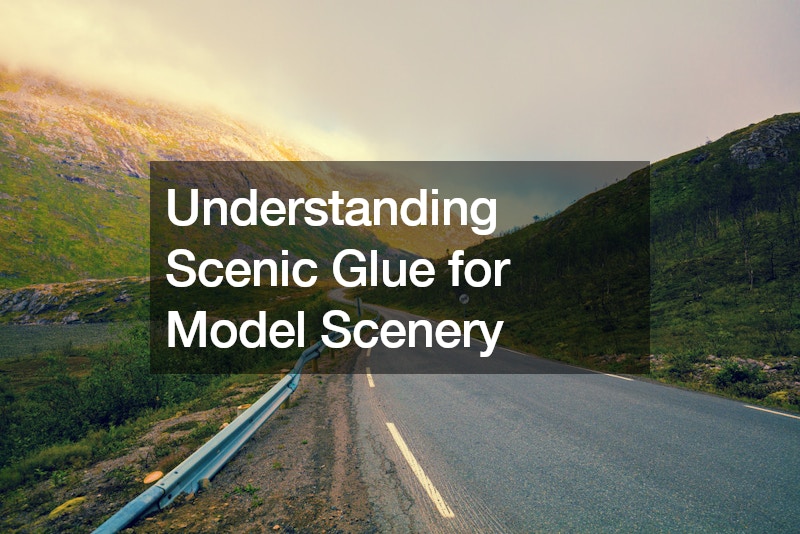Understanding Scenic Glue for Model Scenery

Scenic glue is a vital component in the creation of realistic landscapes for model railways and dioramas. Luke, from the YouTube channel Small World, demonstrates a simple yet effective method using Mod Podge matte. This glue is preferred for its ability to dry without leaving a shine, crucial for maintaining a natural look. The mixture consists of one part Mod Podge to three parts water, with a few drops of liquid washing detergent to break down surface tension. This mixture can be made in advance and stored for later use, making it convenient for large projects.
When applying the glue, Luke suggests pre-wetting the area with water or alcohol. This prepares the surface for better adhesion. He describes three main methods for applying the glue: painting it over the surface before adding ground material, spraying it from a fine mist bottle to build up layers, and using an eye dropper to target specific areas. Each method has its advantages depending on the type of scenery being created. Undiluted Mod Podge can also be used to fix larger pieces of scenery in place and apply static grass, further adding to its versatility.
For model enthusiasts, understanding the importance of scenic glue and how to use it effectively can greatly enhance the realism of their layouts. The ability to create natural-looking landscapes is key to immersing viewers in the miniature world being created. Luke’s demonstration offers a practical and accessible approach, encouraging modelers to experiment and find the best techniques for their projects. By using Mod Podge matte and following these methods, hobbyists can elevate their model scenery to new levels of realism and detail by using model scenery supplies.
Tips for Applying Scenic Glue
Luke emphasizes the importance of experimenting with different ratios and techniques to find what works best for individual projects. While the standard ratio of one part Mod Podge to three parts water is a good starting point, some may find that slightly adjusting the ratio provides better results for their specific needs. Additionally, mixing more glue than needed for one project allows for spare glue to be readily available for future use, saving time and effort.
When applying the glue, it’s crucial to ensure that it is mixed evenly to avoid inconsistencies in the final result. Luke recommends stirring the mixture if it has been sitting for a while to recombine any separated components. This ensures that the glue is applied smoothly and consistently, resulting in a more realistic and cohesive scenery. Additionally, using a fine mist spray bottle for application helps achieve a more even distribution of the glue, especially when building up layers of scenery.
Enhancing Realism with Static Grass Application
Static grass is a popular choice for adding texture and realism to model scenery, mimicking the look of natural grasses and vegetation. Luke demonstrates how to apply static grass using Mod Podge matte as the adhesive. He applies the glue in a diluted form using an eye dropper, allowing it to soak into the previous layer of grass and enabling the addition of multiple layers. This technique helps create a more natural and varied appearance, enhancing the overall realism of the scenery.
To further enhance the realism of the scenery, Luke uses an airbrush to paint the static grass. This allows for precise control over the color and appearance of the grass, enabling modelers to achieve the desired look for their layout. By painting the grass with different colors, modelers can create a more diverse and natural-looking landscape, adding depth and interest to their scenery. Additionally, Luke suggests using undiluted Mod Podge to fix larger pieces of scenery in place, such as clump foliage and trees, further adding to the realism of the scene.
Securing Your Model Scenery
Once your model scenery is complete, it’s essential to secure it in place to prevent any accidental damage or shifting. Luke recommends using undiluted Mod Podge to fix larger pieces of scenery, such as trees and signs, in place. This adhesive is strong enough to hold these items securely while still allowing for adjustments if needed. For added security, especially in areas with frequent handling or movement, consider using a stronger adhesive or epoxy resin to ensure long-lasting stability.
Conclusion
Creating realistic and detailed model scenery requires the right techniques and model scenery supplies, and scenic glue is a crucial component in achieving this realism. By following Luke’s tips and using Mod Podge matte as your scenic glue, you can create stunning landscapes that bring your model railway or diorama to life. Experiment with different ratios and application methods to find what works best for your projects, and don’t be afraid to get creative with painting and detailing to enhance the realism of your scenery. With the right tools and techniques, you can create model scenery that truly captivates and impresses.
.
